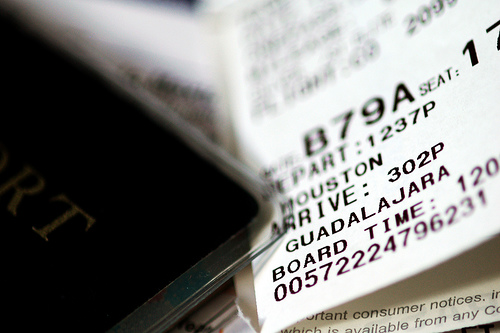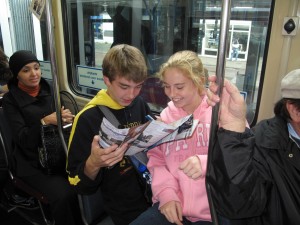My Life with Full Suitcases from Condé Nast Traveler on Concierge.com
I love to travel, I love to shop, I love to buy things from places that took me a long time to get to. I buy to remember where I have been. Enjoy this story taken from my favorite magazine, Conde Nast Traveler
Sometimes there’s nothing as transporting as the perfect piece of clothing from a far-off land. Joan Juliet Buck explores the magic and meaning of the treasures in her wardrobe
In Ireland back when newscasters opened the evening news by announcing, “The time is approximately eight o’clock,” my godfather’s wife Ricki would bundle the guests into two Opel station wagons and lead the way up into Connemara, to Millars’s shop in Clifden, so that the Mexican musician and the French movie producer and the Swiss actress could buy things made of wool. It was three hours of motion sickness, alleviated only by word games. A mere half an hour away in Galway was a perfectly good store called O’Maille, and pronounced Omalia, full of tweeds and sweaters. But the long trek to Clifden brought access to rarer, richer tweeds in better colors, and thickly cabled sweaters hot from the gnarled hands of knitters on the wind-beaten Aran Islands. Millars’s tweeds were hand woven next to the shop, so that Ricki Huston could order personal color combinations which suggested, say, a rainy sunset on the Atlantic, or mulberries in cream; six months to a year later, she’d have a bolt of her own.
In that cave of authenticity, we ran our hands over the halo of white fuzz that rose from the rough tweeds, to check whether the blue felt the same as the pink. We girls were measured for some kind of west Ireland folk costume: madder-dyed red skirts of scratchy baínín with two velvet bands near the hem. By the time they were ready, we had outgrown them but bore the tight waistbands on the thick costumes with dignity because they were the real thing.
We tried on pebbly fishing hats, and wound the long crios sashes around our waists for a high generic folk look, especially when we added the mirrored skullcaps that my godfather had picked up in Kabul. I didn’t yet know that most cultures with flocks of woolly sheep—Greeks, Bulgarians and Turks, the Hopi and the Navajo—made the same belts.
One day, we found a pile of pale striped flannel farmer’s shirts left over from the past. They were 20 years old or 60 or older—ancient enough to be messengers from history. The collarless shirts had buttons to the sternum, their backs were longer than the fronts, and they smelled slightly oily. We were overjoyed: Now we could dress with the austere integrity of simple farmers. The shirts were infinitely too big for us, so we added belts and became Russian revolutionaries, which intensified our allegiance to the lot of the common man, allowing us to roar out old Irish revolutionary songs with new conviction. On the other hand, the designer Donald Davies had copied these same shapes for his collection of fine tweeds in Dublin, London, and Paris, so that by rooting around at Millars’s, we’d become as chic as our mothers.
Millars’s was my first exposure to the paradoxical magic of garments that are apart from fashion and out of time. If I’d been raised in America, the same thing would have happened with Mexican fiesta skirts on a trip to Tijuana, and I would have come home swirling flounces, stamping my feet, and shouting “¡Arriba!” instead of wailing “Kevin Barry gave his young life for the cause of liberty…”
It was the beginning of a life of very full suitcases and incongruous, contradictory sartorial allegiances. Wearing the vast flannel shirts prepared me for the Marxist viewpoint of the lycée teachers, and within a year I had hunted down a Mao jacket in a china shop in Paris. The way the indigo cotton felt on my back put me in sympathy with the shouting Chinese mobs I saw on television as the Cultural Revolution began. Ricki Huston gave me a Mexican red leather belt studded with nail heads, which might have belonged to a female bandit. On Portobello Road, I found an old Egyptian dress made of black netting covered in a pattern of silver; the effect was Cairo whorehouse, 1919. As an antidote, my mother took me to Lisbon and bought me a bracelet of pearls and carnelian beads to grant me the dainty demeanor of a Lusitanian debutante.
I was primed for costume by a childhood in which every adult getting off a plane handed over a doll in national dress: There was a fierce Spanish Gypsy dancer with dangerous eyes, a matador with a sharp sword and an embroidered suit of lights, a geisha with a startled porcelain face peering down at her beige and coral kimono, Austrian dolls in dirndls, and endless regional French dolls—a Niçoise with a straw hat and a bunch of toy mimosa in a toy basket, an Alsacienne with a giant black bow on her head, a Bretonne with a coif like a sugar loaf. The clichés stuck: In Spain I bought flamenco dancer earrings and shoes to align myself with the free spirit of untamed Gypsies.
By then London was in full Haute Boho mode. In Morocco, at Agadir, I bought a red cape and wore it to ride into the desert on horseback, but back in London it looked a little too plain. Every hostess entertained in silk caftans that hid the figure but implied the wearer had “It”—the term for sex appeal coined by Elinor Glyn, the original flame-haired temptress. Her 1907 novel, Three Weeks, about the seduction of a young British aristocrat, had outraged the Edwardian bourgeoisie. A designer named Thea Porter imported antique Oriental fabrics, sewed them up with chiffon, then added beads and braid, and the grande dames, from Lady Antonia Fraser to Edna O’Brien to Bubbles Harmsworth, wafted about in multicolored Eastern silks like dominant harem hens. No one wore a sari—that would have been an improper use of native costume, given Britain’s imperial past. Their generation had swooned over the saturated romance of Lesley Blanch’s 1954 book, The Wilder Shores of Love, and wanted to emulate its heroines: Aimee Dubucq de Rivery, captured by pirates to become a sultan’s favorite; Jane Digby, who married a sheikh; Isabelle Eberhardt, who went about the Sahara dressed as a bedouin.
Thea Porter’s trove of caftans, embroideries, and golden patchworks produced an Orientalist mirage in Belgravia living rooms, but it was expensive. We younger ones had to make do with what we found at one of the India Craft shops that dotted London: enough plastic bangles and dangling earrings to push the paisley on a nylon jersey top-and-pants set into the facsimile of something exotic. But it wasn’t authentic.
For that we had to get out of town and hit the figurative silk road, which historically wound from the Mediterranean through Samarkand into China. In the seventies, the Soviets had locked up Central Asia, no one went to China, and the only person to venture north of the Karakorum was Bruce Chatwin. But there was Nepal. There was India and Turkey and Morocco and Bali. The boys went for the drugs, and the girls went for the finery, and came home wearing things I had never seen: a tall blonde in a salwar kameez from Peshawar, with a dupatta slung over one shoulder; a small brunette in a tiny mirrored kanchali that fastened at the back with ancient ribbons over a great pleated patterned skirt, which she told me was called a ghagra. They all wore kurtas, fine cotton tunics from India and Nepal. Those who went to North Africa came back with Palestinian thobes, long dresses embroidered with red cross-stitching. Salwar kameez! Dupatta! Kanchali! Ghagra! The younger generation, done up in medleys of exotic swag, made the Belgravia caftans look tame. The grande dames turned to Zandra Rhodes for improbable crinolines in yards of organdy printed with zany doodles, and Belgravia living rooms began to look like the hallucinations that the younger set was having on LSD.
I never took the silk route, but I went to New York, where a man named Sam Hilu sold the same clothes that my adventurous friends had risked health and sanity to find at the far ends of the earth. A short trip down to Sam Hilu’s Odyssey warehouse on lower Fifth Avenue and I was in many other worlds at once. Here were infinite numbers of kurtas, with and without embroidery; by now Sam Hilu’s imported kurtas were in stores on every street, and although no one was ever sure if they were meant to be worn over jeans or to sleep in, they were basic summer wear. Sam had a few wedding takchitas; some thobes; and Afghani winter coats—reversed sheepskins embroidered in bright silk flowers—that gave off a light aroma of livestock. I found a Chinese skirt that thrilled me with its oddness: a high blue cotton waistband above strict pleats in orange and black, with toggle buttons. And then there were the necklaces: tinkling shreds of silver metal set with turquoises and sewn onto red cotton bands that tied with string, tiny beads woven into flat patterned pendants, long round silver chains to use as belts. I saved up to buy a heavy silver cuff, its edges lined with triangular points. It was set with carnelians, paler than the ones on the Lisbon debutante bracelet. These were warrior stones, and they had lived.
I returned to London decked out in a mixture of red tribal textiles—who needed to sew when you could drape, pin, and belt with sashes?—and hung about with large pieces of tarnished silver. The effect was a loud mixture of Oriental seduction and tribal aggression. I was not a real hippie—no VW van, no serious drug use, no tolerance for loud music—but my allegiance was with the authentic as represented by exotica. I was looking for soul.
The soul is in the body. There are certain atavistic gestures that humans make, ancestral tics that have nothing to do with the present culture. They are physical and unconscious. The sudden jerking of the legs as you fall asleep is a neurological vestige of the time when we were baboon-like creatures who slept in trees, ancient wiring kicking in to stop the body from falling off a branch. The same kind of wiring template exists, I think, for clothes and adornment. Ears have been pierced since antiquity. The act of wrapping a piece of cloth around your body feels good, like a hug. Securing something at the waist with a knot is physically satisfying. It may account for the popularity of Diane von Furstenberg’s wrap dress.
And then there are shawls. Covering the head is an instinctive gesture that has become a religious and political bombshell. Rummaging around Sam Hilu’s Odyssey warehouse, I found that my hair never looked right with any of the things I tried on. My hands automatically went to his scarves, and without thinking I’d wrap them around my head, several at a time, for an effect that was sometimes a turban and sometimes exactly what women wear in the Balkans, the Caucasus, or North Africa. My unconscious gesture reproduced the Jewish mitpachat and the Muslim hijab.
In fundamentalist Muslim countries, religious law imposes the full veil. In Saudi Arabia and the Gulf states, the flowing black niqab turns women into moving monoliths. The burqa is the symbol of repression in Afghanistan. The shielding, covering, erasing, confining veils contract into headscarves that Muslim women wear to signal their faith, whatever country they live in. In France, headscarves have just been banned in schools. They’re not just scarves. Folk costume and all forms of traditional dress carry a force, whether they are durably sewn for toil, patterned as symbols of fertility, adorned to convey power, or cut to make noise and displace air in celebrations. The force is like mana, the mystical charge described in Margaret Mead’s books about Polynesia, or the numen of the Romans. Mana is the soul of an inanimate object, and it attracts that which most resembles it. It also repels that which least resembles it. Ethnologists will tell you that the arrangement of cross-stitches on Bulgarian wedding shirts or the rhythm of contrasting colors on ikats represent the Great Goddess. Things made by hand in the same way in the same place for centuries have more power than T-shirts from Wal-Mart, but nothing you put on your back is neutral. No wonder when we travel, we shop. We are looking for our ancestors.
In Moscow in July 1989, during the transition from perestroika to nascent capitalism, the uncertain but elated Russians were still doughy, most women shaped like loaves, all of them dressed in clothes that reflected long Orwellian hours of standing in line with insufficient coupons to buy inferior goods. But among the crowds of babushkas and nylon-shirted dumplings, I saw graceful people whose existence I had never suspected: Central Asians, Uzbeks and Kazakhs, Turkmens, Kyrgyzs, and Tajiks. Tall men and slender women, the women with long black hair in braids down their backs, both sexes wearing long bright cotton coats. I wanted one. Gum, the department store on Red Square, displayed only alternating rows of gray socks and small cellophane-wrapped packages of macaroni.
I asked someone who asked someone who knew someone, I handed over a $20 bill, and later that day was given a turquoise coat, channel quilted over cotton and lined with a flower print. It didn’t really fit. It was stiff and straight, and the sleeves were far too long. Peering into the mirror of my tiny room in the horrendous Rossiya hotel, I realized that to get a fuller effect I needed a kurta in an ikat fabric to wear underneath it. I asked the someone who knew someone, but that was too much to ask.
“Go to the tourist shop,” he said. “They have things there.”
“Tourist shop?” I asked.
The hotel had 3,200 rooms. I pounded the corridor from the European section (where I had been put because I had come off the plane with a French delegation), turned left through the Georgian and Caucasus section, where large mustachioed men in singlets loitered at their open doors proffering bottles of arak, turned left again past a cafeteria where policemen with plastic totes lined up to buy sturgeon, and left again into the American section—now a good half mile of hotel corridor away from my room—and rode a cavernous elevator down to the gift shop. A neon-lit place with glass counters, it had the charm of a dispensary. A very large dispensary.
On the walls behind the counter was hung Russian amber. Miles of Russian amber from the Baltic Sea. Necklaces hanging on hooks, chunks strung with chunks, beads with beads. The chunks were pale, irregular, and matte, in every shade of cheese: palest provolone, variegated parmesan, Kraft yellow, deep cheddar. The beads were shiny, in every shade of liquor: Armagnac, bourbon, whiskey, beer, brandy, even cherry brandy.
I was suddenly beset by greed for food, alcohol, and adornment. If I chose a crumbly pale yellow, I had to have smooth brandy beads; but then I wanted a dash of bourbon, and some gouda to offset that. A necklace of chardonnay caught my eye, and another, darker, like Château d’Yquem.
Drunk on the sight of petrified resin, I spent all my money on too many amber necklaces. Back in New York, there were days when they made me look like an expression of nature come to life, and days when I looked like a crazed schoolteacher.
One night in Paris in 1993, I wore rather too many of them to a dinner for some Tibetan monks. We were in the house of a famous and aristocratic explorer. The spoils of his travels were on display—tribal masks, boxes, treasures. I found myself standing next to a monk, an older man with a shaved head, one bare arm protruding from brown and orange robes. Both of us were staring at an arrangement of immense ceremonial amber necklaces from Tibet. He looked at the necklaces and then looked at me. I looked at the necklaces and looked at him. His eyes went to the five strings of Baltic amber around my neck and back to the table and back to my eyes.
I got the hint and did the only thing possible. I pulled the longest necklace over my head and, bowing deeply in what I hoped was the correct attitude of veneration, held the necklace out to him. He took it with a smile. It felt good. As if by making possible a gift to a holy man, that moment of insane greed in the tourist shop in Moscow had now revealed its purpose.
My Life with Full Suitcases from Condé Nast Traveler on Concierge.com


